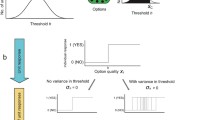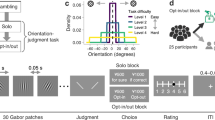Abstract
Condorcet [2] proposed that a majority vote drawn from individual, independent and fallible (but not totally uninformed) opinions provides near-perfect accuracy if the number of voters is adequately large. Research in social psychology has since then repeatedly demonstrated that collectives can and do fail more often than expected by Condorcet. Since human collective decisions often follow from exchange of opinions, these failures provide an exquisite opportunity to understand human communication of metacognitive confidence. This question can be addressed by recasting collective decision-making as an information integration problem similar to multisensory (cross-modal) perception. Previous research in systems neuroscience shows that one brain can integrate information from multiple senses nearly optimally. Inverting the question, we ask: under what conditions can two brains integrate information about one sensory modality optimally? We review recent work that has taken this approach and report discoveries about the quantitative limits of collective perceptual decision-making, and the role of the mode of communication and feedback in collective decision-making. We propose that shared metacognitive confidence conveys the strength of an individual’s opinion and its reliability inseparably. We further suggest that a functional role of shared metacognition is to provide substitute signals in situations where outcome is necessary for learning but unavailable or impossible to establish.
This chapter is adapted from: Bahrami B, Olsen K, Bang D, Roepstorff A, Rees G, Frith C (2012) What failure in collective decision-making tells us about metacognition. Phil Trans R Soc B 367:1350–1365
Access this chapter
Tax calculation will be finalised at checkout
Purchases are for personal use only
Similar content being viewed by others
Notes
- 1.
Interestingly, his major case studies, financial bubbles and religious conflicts over Jerusalem, do not show any signs of running out of steam yet.
- 2.
The names chosen for the cricket umpires are inspired by Graham Greene’s (1940) The Power and the Glory (Qodrat o Jalal).
- 3.
The confidence ratio µ i /σ i can be monotonically transformed into P(x > 0), which gives the probability of being correct given perceptual sample x. The decision rule (µQ/σQ + µJ/σJ) is thus equivalent to accepting the decision of the person with the higher probability of being correct (i.e. the higher confidence µ i /σ i ). See the Supplementary Materials to Bahrami et al. [9] for further mathematical details.
- 4.
Thomas Bayes (http://bit.ly/f0uTBk) would perhaps have found the bias for favouring redundant and frequent information only wise and sensible. In the words of Bellman in Lewis Carrol’s brilliant The Hunting of the Snark,
‘JUST the place for a Snark!’ the Bellman cried,
As he landed his crew with care;
Supporting each man on the top of the tide
By a finger entwined in his hair.
‘Just the place for a Snark! I have said it twice:
That alone should encourage the crew.
Just the place for a Snark! I have said it thrice:
What I tell you three times is true.’
References
Mackay C (1841) The extraordinary and popular delusions and madness of crowds, 4th edn. Wordsworth Editions Limited, Ware
Condorcet M (1785) Essai sur l’application de l’analyse á la probabilité des décisions rendues á la pluralité des voix. de l’Impr. royale, Paris
Galton F (1907) Vox populi. Nature 1949(75):450–451
Kerr NL, Tindale RS (2004) Group performance and decision making. Annu Rev Psychol 55:623–655
Lorenz J, Rauhut H, Schweitzer F, Helbing D (2011) How social influence can undermine the wisdom of crowd effect. Proc Natl Acad Sci USA 108(22):9020–9025
Alais D, Burr D (2004) The ventriloquist effect results from near-optimal bimodal integration. Curr Biol 14(3):257–262
Deneve S, Latham PE, Pouget A (2001) Efficient computation and cue integration with noisy population codes. Nat Neurosci 4(8):826–831
Ernst MO, Banks MS (2002) Humans integrate visual and haptic information in a statistically optimal fashion. Nature 415(6870):429–433
Bahrami B, Olsen K, Latham PE, Roepstorff A, Rees G, Frith CD (2010) Optimally interacting minds. Science 329(5995):1081–1085
Sorkin RD, Hays CJ, West R (2001) Signal-detection analysis of group decision making. Psychol Rev 108(1):183–203
Ma WJ, Beck JM, Latham PE, Pouget A (2006) Bayesian inference with probabilistic population codes. Nat Neurosci 9(11):1432–1438
Keysar B (2007) Communication and miscommunication: The role of egocentric processes. Intercultral Pragmatics 4(1):71–84
Gilovich T, Savitsky K, Medvec VH (1998) The illusion of transparency: Biased assessments of others’ ability to read one’s emotional states. J Pers Soc Psychol 75(2):332–346
Keysar B, Lin S, Barr DJ (2003) Limits on theory of mind use in adults. Cognition 89(1):25–41
Corallo G, Sackur J, Dehaene S, Sigman M (2008) Limits on introspection: distorted subjective time during the dual-task bottleneck. Psychol Sci 19(11):1110–1117
Ericsson KA, Simon HA (1980) Verbal reports as data. Psychol Rev 87(3):215–251
Sandberg K, Timmermans B, Overgaard M, Cleeremans A (2010 ) Measuring consciousness: is one measure better than the other? Conscious Cogn 19(4):1069–1078
Latane B, Williams K, Harkins S (1979) Many hands make light the work—causes and consequences of social loafing. J Pers Soc Psychol 37(6):822–832
Karau SJ, Williams KD (1993) Social loafing—a metaanalytic review and theoretical integration. J Pers Soc Psychol 65(4):681–706
Olsen K, Christensen P, Bang D, Roepstorff A, Rees G, Frith C, Bahrami B (In preperation) Interaction accelerates the rate of visual perceptual learning in humans
Zajonc RB (1965) Social facilitation. Science 16(149):269–274
Williams K, Harkins S, Latane B (1981) Identifiability as a deterrent to social loafing: two cheering experiments. J Pers Soc Psychol 40(2):303–311
Turner ME, Pratkanis AR (1998) Twenty-five years of groupthink theory and research: Lessons from the evaluation of a theory. Organ Behav Hum Decis Process 73(2–3):105–115
Raafat RM, Chater N, Frith C (2009) Herding in humans. Trends Cogn Sci 13(10):420–428
Hastie R, Kameda T (2005) The robust beauty of majority rules in group decisions. Psychol Rev 112(2):494–508
Stasser G, Titus W (1985) Pooling of unshared information in group decision-making: biased information sampling during discussion. J Pers Soc Psychol 48(6):1467–1478
Stasser G, Titus W (1987) Effects of information load and percentage of shared information on the dissemination of unshared information during group discussion. J Pers Soc Psychol 53(1):81–93
Stasser G, Titus W (2003) Hidden profiles: a brief history. Psychol Inq 14(3–4):304–313
Fusaroli R, Bahrami B, P, Olsen K, Roepstorff A, Frith C, et al. (2011) Coming to terms: an experimental quantification of the coordinative benefits of linguistic interaction. Under review 2011
Bahrami B, Olsen K, Bang D, Roepstorff A, Rees G, Frith C (2011) Together, slowly but surely: the role of social interaction and feedback on the build-up of benefit in collective decision-making. J Exp Psychol Human Percept Perform 38:3
Burge J, Girshick AR, Banks MS (2010) Visual-haptic adaptation is determined by relative reliability. J Neurosci 30(22):7714–7721
Behrens TE, Hunt LT, Woolrich MW, Rushworth MF (2008) Associative learning of social value. Nature 456(7219):245–249
Behrens TE, Hunt LT, Rushworth MF (2009) The computation of social behavior. Science 324(5931):1160–1164
Hampton AN, Bossaerts P, O’Doherty JP (2008) Neural correlates of mentalizing-related computations during strategic interactions in humans. Proc Natl Acad Sci USA 105(18):6741–6746
Austen-Smith D, Banks J (1996) Information aggregation, rationality, and the condorcet jury theorem. Am Political Sci Rev 90(1):34–45
Blackwell D, Girschick MA (1954) Theory of games and statistical decisions. Wiley, New York
Maloney LT (2002) Statistical decison theory and biological vision. In: Heyer D, Mausfeld R (eds) Perception and physical world. Wiley, New York, pp 145–189
Pierce CS, Jastrow J (1884) On small differences in sensation. Mem Natl Acad Sci 3:75–83
Wald A (1947) Sequential analysis. Wiley, New York
Gold JI, Shadlen MN (2007) The neural basis of decision making. Annu Rev Neurosci 30:535–574
Ratcliff R (1978) Theory of memory retrieval. Psychol Rev 85(2):59–108
Vickers D (1979) Decision processes in visual perception. Academic, New York
Heath RA (1984) Random-walk and accumulator models of psychophysical discrimination: a critical evaluation. Perception 13(1):57–65
Kepecs A, Uchida N, Zariwala HA, Mainen ZF (2008) Neural correlates, computation and behavioural impact of decision confidence. Nature 455(7210):227–231
Kiani R, Shadlen MN (2009) Representation of confidence associated with a decision by neurons in the parietal cortex. Science 324(5928):759–764
Pleskac TJ, Busemeyer JR (2010) Two-stage dynamic signal detection: a theory of choice, decision time, and confidence. Psychol Rev 117(3):864–901
Glimcher PW, Rustichini A (2004) Neuroeconomics: the consilience of brain and decision. Science 306(5695):447–452
Hsu M, Bhatt M, Adolphs R, Tranel D, Camerer CF (2005) Neural systems responding to degrees of uncertainty in human decision-making. Science 310(5754):1680–1683
Huettel SA, Stowe CJ, Gordon EM, Warner BT, Platt ML (2006) Neural signatures of economic preferences for risk and ambiguity. Neuron 49(5):765–775
Platt ML, Huettel SA (2008) Risky business: the neuroeconomics of decision making under uncertainty. Nat Neurosci 11(4):398–403
Fleming SM, Dolan RJ (2010) Effects of loss aversion on post-decision wagering: implications for measures of awareness. Conscious Cogn 19(1):352–363
Ernst MO (2010) Behavior. Decisions made better. Science 329(5995):1022–1023
Fisher RA (1921) On the probable error of a coefficient of correlation deduced from a small sample. Metron 1(4):3–32
Acknowledgments
This work was supported by a British Academy postdoctoral fellowship (BB), European Research Council (NeuroCoDec, grant number 309865), the Calleva Research Centre for Evolution and Human Sciences (DB), the Danish National Research Foundation and the Danish Research Council for Culture and Communication (BB, KO, AR, CF) and by the Wellcome Trust (GR). Support from the MINDLab UNIK initiative at Aarhus University was funded by the Danish Ministry of Science, Technology and Innovation.
Author information
Authors and Affiliations
Corresponding author
Editor information
Editors and Affiliations
Rights and permissions
Copyright information
© 2014 Springer-Verlag Berlin Heidelberg
About this chapter
Cite this chapter
Bang, D. et al. (2014). What Failure in Collective Decision-Making Tells Us About Metacognition. In: Fleming, S., Frith, C. (eds) The Cognitive Neuroscience of Metacognition. Springer, Berlin, Heidelberg. https://doi.org/10.1007/978-3-642-45190-4_9
Download citation
DOI: https://doi.org/10.1007/978-3-642-45190-4_9
Published:
Publisher Name: Springer, Berlin, Heidelberg
Print ISBN: 978-3-642-45189-8
Online ISBN: 978-3-642-45190-4
eBook Packages: Biomedical and Life SciencesBiomedical and Life Sciences (R0)




